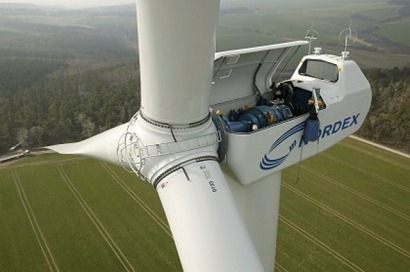
The statistics, which were related in conjunction with the German Wind Energy Association (BMW) and the German Engineering Federation (VDMA Power Systems), show that 1,551 MW of new wind power capacity was installed across Germany last year, a 19 percent decline from the 1,917 MW in new capacity installed in 2009.
A total of 21,607 wind turbines with an overall capacity of 27,214 MW were in service in Germany at the end of 2010.
“This means that the German market is back to its 1999 level,” said Thorsten Herdan, Managing Director of VDMA Power Systems. “The fall-off in the onshore market can be ascribed to the knock-on effects of the financial crisis on major projects and to uncertainties regarding the grid requirements that apply to wind turbines."
Hermann Albers, President of the BWE, said an additional factor was that the land available for new turbines is being further reduced despite the designation of new sites in certain federal states in Germany.
“Spacing requirements and height limits are hindering the efficient expansion of onshore wind power,” Albers said.
Growth spurred by turbine replacement
Growth relative to the previous year took place in the replacement of old wind turbines with new, more powerful turbines – a process known as repowering.
According to data collected by the DEWI, as many as 116 wind turbines with a combined capacity of 56 MW were replaced by 80 wind turbines with an overall capacity of 183 MW in 2010.
"Repowering still harbours a huge amount of untapped potential. By 2015 at the latest, over 9,500 wind turbines will be candidates for repowering," said Albers. "This corresponds to a potential investment volume of 40 billion euros."
Wind power at sea also exceeded the installation figures for the previous year. In the German offshore market's second year, a total of 108 MW of new capacity was installed in the Baltic 1 und Bard 1 projects.
"The expected level of 150 MW of new installations was not achieved, but the 100 MW threshold has nonetheless finally been broken,” Herdan said. “You simply have to realize that offshore is a new technology, its development will take time, and that the amount of finance available is limited. However, we are on the right road. Based on the progress of current projects, it is likely that 300 MW will be achieved by 2011."
Given the study’s findings, both men predicted the importance of export markets to the German wind industry will continue to grow.
“We assume that China has grown further in 2010. However, the size of the important export market in the USA halved to 5,115 MW,” Herdan said. “The looming end to investment tax credits at the end of 2010 and the ongoing discussions about changing the support mechanism over to a quota model – the so-called Renewable Portfolio Standard that will apply nationwide – have had a further negative effect on investment conditions.”
Consolidation necessary
Casting an eye to the US market, Herdan said, “Something similar to what happened in the USA in 2010 should not be allowed to happen here in Germany in 2011”.
“The amendments to the German Renewable Energy Sources Act should not worsen the investment conditions on the domestic market; instead, the German market needs to be consolidated,” he said.
Albers agreed, saying that uncertainties in the legislative process should be avoided in Germany.
He also noted that the ongoing development of the European grid infrastructure and of the energy policy framework conditions will have a decisive influence on the successful expansion of wind power.
"The debate about the harmonization of support mechanisms for renewable energy sources is impacting negatively on the progress of wind, solar and other renewable energies in the EU," he said.
But, he cautioned, the EU directive, which only came into force in 2009, needs to be implemented in a complete and ambitious manner if its specified expansion targets for the EU and its member states are not to be jeopardized.
"If harmonization is implemented too quickly, this could lead to uncertainties in important sales markets. It is in the interest of the wind industry in Germany and Europe that this be avoided," Albers said.
For additional information:

